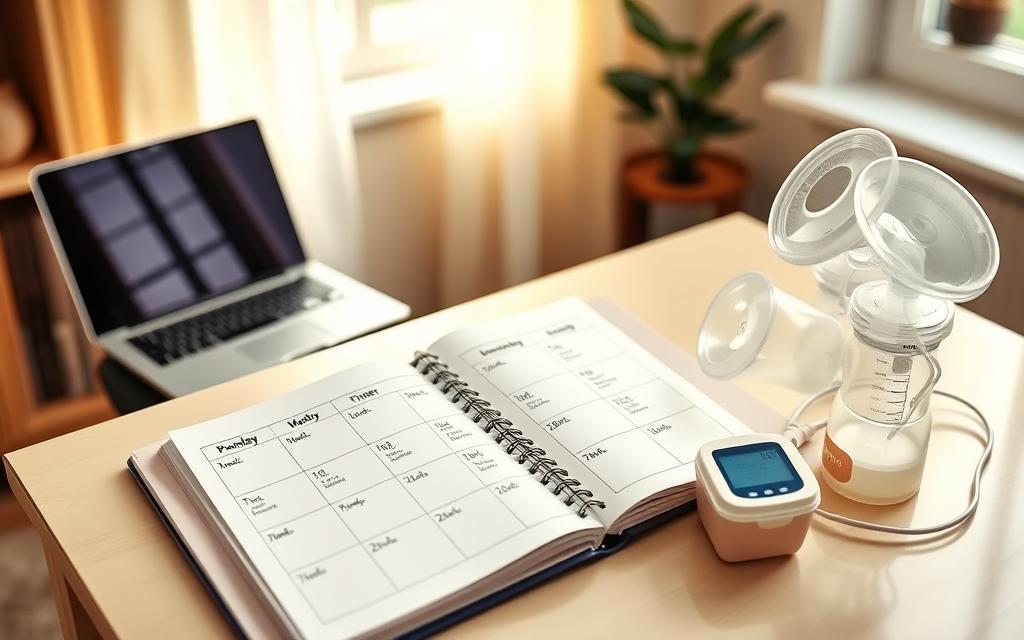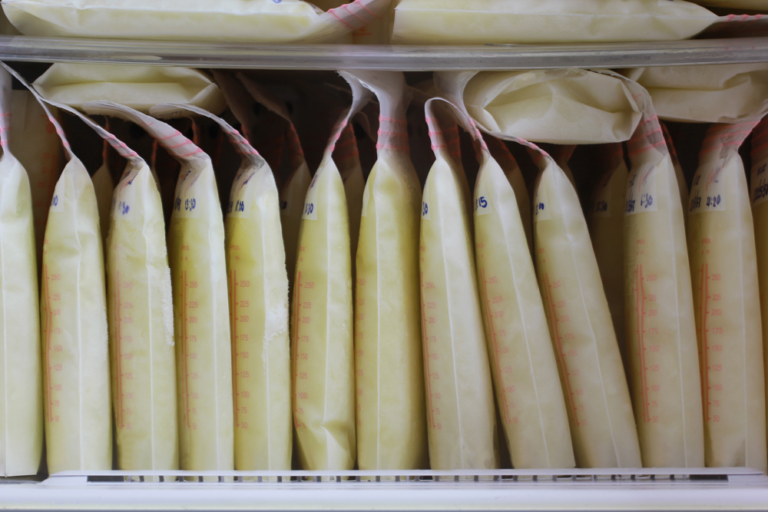Effective Pumping Techniques to Increase Milk Supply

As a new mom, getting a good milk supply is key. It’s important to often stimulate your breasts, either by nursing or pumping. This is vital in the first weeks after birth to build up your milk supply.
Using the right pumping techniques can boost your milk production. Understanding how milk is made helps you get the most from your pumping sessions. By adding these techniques to your daily routine, you can increase your milk supply and feed your baby well.
To pump more milk, you need to pump often, use the right gear, and stick to a routine. Pumping every three hours and for 15 minutes every two hours is a good start. Also, power pumping, like pumping for 10 minutes on and 10 minutes off, can help too.
Key Takeaways
- Frequent stimulation of the breasts is key for a good milk supply.
- Good pumping techniques can up your milk supply.
- Pumping every three hours and for 15 minutes every two hours is a good start.
- Power pumping can also boost your milk supply.
- Right equipment and a steady routine are vital for pumping more milk.
- Boosting milk supply through pumping ensures your baby gets enough to eat.
Understanding Your Milk Production Cycle
As a new mom, knowing how your body makes milk is key for a good breastfeeding journey. With the right tips and support, you can face challenges and bond with your baby. Milk starts right after birth, with colostrum, the first milk, coming out when your baby latches and sucks.
By day three, your milk usually “comes in,” making your breasts feel fuller. How often you breastfeed affects your milk supply. Newborns might feed every 45 minutes, helping to build a strong milk supply. With the right advice, you can get through this important time and establish a healthy milk supply.
- Removing milk often, through breastfeeding or pumping, tells your body to make more.
- The FIL helps control milk production; fuller breasts make less milk than emptier ones.
- Starting formula too early can greatly reduce breast milk because it means less milk is removed.
By understanding these points and using good lactation tips and support, moms can overcome hurdles and have a successful breastfeeding journey.
Essential Equipment for Successful Pumping
Having the right pumping equipment is key for a smooth pumping journey. A good breast pump that fits well is a must. Electric breast pumps are better for daily use than manual ones. It’s important for mothers to know what pumping equipment and accessories they need.
When picking a breast pump, look for a good fit, comfort, and ease of use. Ameda has CustomFit Breast Pump Flanges for different nipple sizes. This ensures a proper fit and comfort. A hands-free pumping bra can also make double pumping more comfortable and efficient.
- Choose an electric breast pump for frequent use
- Consider a double electric breast pump for simultaneous expression
- Look for adjustable settings for suction strength and speed
- Invest in a hands-free pumping bra for comfort and efficiency
Investing in the right pumping equipment and accessories is vital. It makes pumping successful and comfortable. Always talk to a healthcare provider or lactation consultant for advice on breast pumps and pumping equipment.
How to Increase Milk Supply While Pumping: Proven Methods
Many mothers worry about increasing their milk supply. Pumping can help a lot. After two to three days, regular pumping can really boost milk production.
There are effective pumping techniques to know. Power pumping is one, where you pump for 10 minutes, then rest for 10. Repeat this for an hour. Lactation consultants often suggest this. Double pumping also works well, as it lets you express more milk in less time.
Benefits of Power Pumping
Power pumping involves a 1-hour routine. Pump for 20 minutes, rest for 10, then pump for 10 minutes twice. This method can really help increase milk supply. Mothers can see a difference in just 3-4 days.
Optimal Pumping Duration
Finding the right pumping time is key. Hands-on pumping can take 25 to 30 minutes. Double pumping is quicker, making it great for busy moms. Mixing these methods with other strategies can help you reach your breastfeeding goals.
Creating an Effective Pumping Schedule
Having a good pumping schedule is key to keeping up your milk supply. It can take six to 12 weeks to get your milk supply right. You might need to pump every three hours if you’re away from your baby.
When making a lactation routine, focus on removing milk well from your breasts. Pump every 3-4 hours for 15-20 minutes. This helps keep your milk supply steady and ensures your baby gets the nutrients they need.

- Pump for 15-20 minutes per session, or until milk flow slows down
- Gradually increase or decrease pumping frequency as needed
- Monitor your baby’s milk intake and adjust your pumping schedule as needed
By following these tips and making a pumping schedule that fits you, you can have a successful lactation routine. It will work for you and your baby.
| Pumping Frequency | Pumping Duration | Milk Intake |
|---|---|---|
| 8-12 times per day | 15-20 minutes per session | 25-30 ounces per day |
Remember, every mother’s experience with pumping and lactation is different. Be patient and don’t be afraid to ask for help from a lactation consultant if you need to create an effective pumping schedule.
Proper Breast Pump Positioning and Fit
A proper breast pump fit is key for effective and comfortable pumping. Mothers must find a breast shield that fits right for good milk removal and comfort. A bad fit can cause discomfort, nipple damage, and less milk.
Choosing the right pumping position is important for comfort and sticking to a routine. For moms after cesarean sections, lying back a bit can help. There are also hands-free options like special bras or DIY solutions for multitasking. Getting the flange size right is also critical; the wrong size can lower suction and milk output.
- Choose the right breast shield size to prevent discomfort and nipple trauma
- Center the flange around the nipple to maximize milk output from alveoli
- Adjust the suction level to a comfortable setting to prevent pain and discomfort
By focusing on comfort and fit, moms can make pumping better and increase milk supply. A well-fitting breast pump is vital for effective milk removal and comfort. This makes it easier to keep up with a pumping routine and feel comfortable while doing it.
Nutrition and Hydration for Maximum Production
Eating well and staying hydrated are key for a good milk supply. Nursing moms need 300 to 500 more calories daily than before pregnancy. This supports lactation and health. A diet full of whole foods helps with milk production.
Some foods and nutrients are great for lactation nutrition:
- Leafy greens like spinach and kale
- Nuts and seeds, such as almonds and pumpkin seeds
- Fatty fish like salmon and sardines
- Whole grains like brown rice and quinoa
Drinking enough water is also vital for milk production. It helps avoid dehydration, which can lower milk supply. Aim for 8-10 glasses of water daily. Some herbs like fenugreek and blessed thistle might also help, but research is mixed.
Drink water often during the day, not all at once. This keeps milk supply steady and supports health. A balanced diet and enough water help nursing moms produce milk and stay healthy.
Troubleshooting Common Pumping Challenges
Mothers often face pumping challenges like low milk supply, nipple soreness, and trouble expressing milk. Finding and fixing these lactation issues early can stop bigger problems. With the right advice and techniques, common challenges can be beaten.
Understanding the cause of pumping challenges is key. Low milk supply can come from not pumping enough. It’s recommended to pump at least once every three to four hours. Also, pumping for 15 to 20 minutes is best, though some may need 30 to 45 minutes, mainly in the early days.
Here are some tips to tackle common lactation issues:
- Replace breast pump parts every couple of months for good suction
- Make sure the flange fits right, leaving 2-5mm space for the nipple
- Avoid painful pumping to help letdown and get more milk
Remember, pumping challenges are different for everyone, and breastfeeding goals vary. By knowing common lactation issues and tackling them, mothers can succeed in breastfeeding.
Storing and Managing Your Pumped Milk
Storing your expressed breast milk right is key to keeping it safe and good quality. Start by picking the best containers – go for BPA-free bottles or bags made for milk storage. Make sure to label each one with the date and time you pumped it. This helps you use the oldest milk first.
For freezing, lay flat milk bags or bottles on a flat surface in the freezer until they’re solid. Then, you can stack or arrange them for better storage. You can keep breast milk in the freezer for up to 12 months. Always check the storage guidelines for the right fridge and freezer times to keep your milk’s nutrients and quality.
milk
Keeping things organized is important for managing your
lactation
well. Keep a log of your pumping sessions, noting the amount and time of each. This helps you track your milk supply and spot any changes. With the right storage and organization, you can be sure your baby gets the best breast milk, even when you’re not there.






